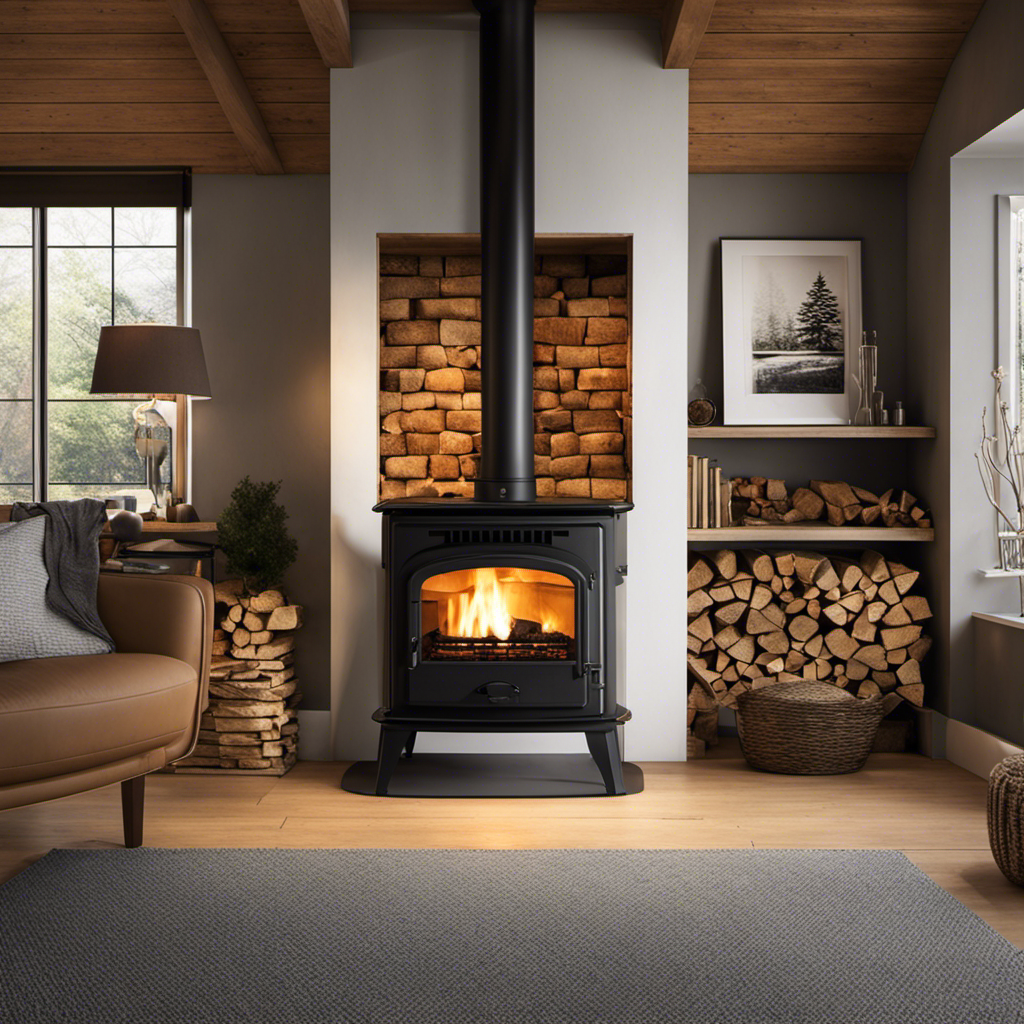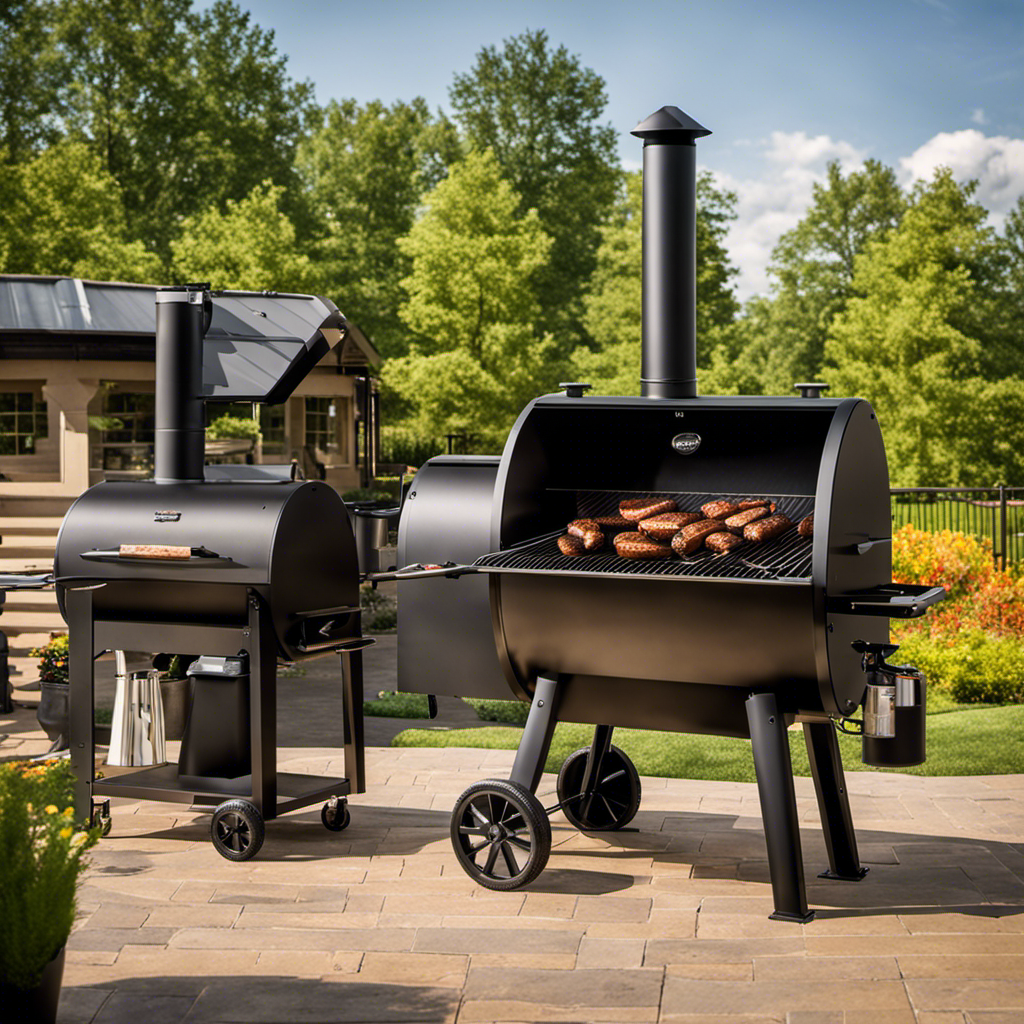I’ve always been fond of the comforting sound of a wood stove crackling, yet at times, I yearn for something more efficient. This led me to create my own pellet basket to enhance my wood stove experience.
With just a few materials and some basic construction skills, I was able to create a simple yet effective device that allows me to burn wood pellets in my stove.
In this article, I’ll walk you through the steps of building your own pellet basket, so you can enjoy the warmth and convenience of pellet burning too.
Key Takeaways
- Materials needed for making a pellet basket for a wood stove include metal mesh basket, fireproof base, pliers, wire, and wood pellets.
- The process of building and securing the pellet basket involves gathering the necessary materials, cutting and forming the frame, adding mesh and securing it tightly with wire, reinforcing the bottom, and ensuring proper placement and anchoring.
- Proper stove ventilation and clearing the stovepipe are essential for efficient burning and to prevent the buildup of harmful gases. This includes adjusting dampers, checking for blockages, and regularly inspecting and cleaning the stovepipe.
- Ensuring an adequate fuel supply is important for continuous operation, optimal stove efficiency, and to avoid fluctuating temperatures. This involves having enough wood pellets, avoiding fuel shortages, and saving on heating costs.
Materials Needed
You’ll need a few materials to make a pellet basket for your wood stove. Choosing the right design for your basket is important to ensure efficient burning and maximum heat output.
One advantage of using a pellet basket is that it allows you to burn wood pellets in your wood stove, which are a cleaner and more efficient fuel source compared to traditional firewood.
To make a pellet basket, you’ll need a metal mesh basket that is sturdy and heat resistant. Additionally, you’ll need a fireproof base to place the basket on, such as a firebrick or a metal plate. These materials will provide a stable and safe foundation for your pellet basket.
Now, let’s move on to choosing the right size for your pellet basket.
Choosing the Right Size
When choosing the right size for your pellet basket, it’s important to consider the dimensions of your wood stove. Sizing considerations and basket capacity are crucial factors that will ensure optimal performance and efficiency.
Here are some key points to keep in mind:
- Measure the width, depth, and height of your wood stove to determine the maximum dimensions for your pellet basket.
- Consider the clearance requirements specified by the manufacturer to ensure proper airflow and prevent overheating.
- Take into account the size of the pellets you plan to use, as different brands may have varying pellet sizes.
- Calculate the basket capacity based on the amount of pellets you want to burn at a time and the burn time you desire.
- Keep in mind that a larger basket capacity may require more frequent refilling, while a smaller capacity may result in more frequent reloading.
Now that you have determined the right size for your pellet basket, let’s move on to building the frame.
Building the Frame
Once you’ve figured out the appropriate size, it’s time to start constructing the frame for your pellet basket. The basket design plays a crucial role in ensuring efficient airflow and combustion.
To begin the basket construction, gather the necessary materials: wire mesh, pliers, and metal rods. Measure and cut the metal rods according to your desired dimensions, typically a rectangular shape. Using the pliers, bend the rods at right angles to form the corners. Secure the corners by twisting the wire tightly around them. This sturdy frame will provide the structure for the basket.
Now, let’s move on to adding the mesh, which will allow the pellets to burn evenly and prevent them from falling through.
Adding the Mesh
To add the mesh, simply cut it to fit the dimensions of the frame and secure it tightly with wire. This step is crucial for the proper functioning of the pellet basket.
The mesh installation allows for the efficient burning of the wood pellets while preventing them from falling out. It is important to choose a mesh that is sturdy and heat-resistant to ensure durability and safety.
Once the mesh is cut to size, carefully attach it to the frame using wire, making sure it is tightly secured on all sides. The mesh also serves another purpose – maintaining basket cleanliness. It keeps the ashes and debris contained, making it easier to clean and maintain the pellet basket.
With the mesh in place, we can now move on to securing the basket…
Securing the Basket
When it comes to securing the basket for your wood stove, there are several key points to consider.
First, we’ll explore basket stability techniques that can help ensure that your basket stays in place during use.
Next, we’ll discuss the different anchoring options available to keep the basket securely attached to the stove.
Finally, we’ll delve into the importance of ensuring a proper basket fit, as this can greatly impact the overall stability and effectiveness of your wood stove.
Basket Stability Techniques
For better stability, you can reinforce the bottom of the pellet basket with an extra layer of mesh. This will help prevent the pellets from shifting and ensure that the basket remains sturdy during use.
In addition to reinforcing the bottom, there are other techniques you can employ to enhance the overall stability of the basket. One effective technique is to fill the basket evenly, ensuring that there are no gaps or spaces between the pellets. This will help distribute the weight evenly and minimize the risk of the basket tipping over.
Another technique is to place the basket on a stable surface, such as a level floor or a non-slip mat. This will provide additional support and prevent any wobbling or movement.
By implementing these stability techniques, you can ensure that your pellet basket remains secure and reliable for efficient pellet storage.
Now, let’s explore the various anchoring options for the basket.
Anchoring Options for Basket
One option you have is using heavy-duty magnets to secure the basket in place.
Heavy-duty magnets provide a strong and reliable anchoring option for your pellet basket. These magnets are specifically designed to withstand high temperatures, ensuring that they won’t lose their magnetic strength over time.
Simply attach the magnets to the sides of your wood stove and place the basket on top. The magnets will hold the basket securely in place, preventing any movement or tipping.
This anchoring method is not only effective but also convenient, as it allows for easy removal and repositioning of the basket when needed.
Now, let’s move on to ensuring proper basket fit, which is crucial for efficient burning and optimal performance.
Ensuring Proper Basket Fit
To ensure a proper fit for your basket, you’ll want to measure the dimensions of your stove and compare them to the size of the basket. This step is crucial for proper basket maintenance and avoiding common issues.
Start by measuring the width, height, and depth of your wood stove. Then, compare these measurements to the dimensions of the basket you intend to use. Make sure the basket is not too small or too large for your stove, as this can affect its efficiency and performance.
If the basket doesn’t fit properly, you may experience problems such as poor heat distribution or difficulty in loading pellets.
Once you have ensured the right fit, you can proceed to the next section on preparing the wood stove for optimal pellet burning.
Preparing the Wood Stove
When it comes to preparing a wood stove, there are three key points to consider: proper stove ventilation, clearing the stovepipe of debris, and ensuring an adequate fuel supply.
Proper stove ventilation is crucial for the safe operation of the wood stove, as it allows for the efficient flow of air and prevents the buildup of harmful gases.
Clearing the stovepipe of debris is important to maintain optimal airflow and prevent blockages that can lead to poor performance or even dangerous situations.
Lastly, ensuring an adequate fuel supply is essential for maintaining a consistent and steady heat output, allowing for a comfortable and efficient heating experience.
Proper Stove Ventilation
Proper stove ventilation is essential for maintaining a safe and efficient wood stove. By ensuring that the stove is properly ventilated, you can prevent the build-up of harmful gases, such as carbon monoxide, and improve the overall performance of your stove.
There are several ventilation techniques that can be employed to achieve optimal results. These include adjusting the dampers, using a stove fan, and installing a chimney cap. Troubleshooting common ventilation issues is also important. This can involve checking for blockages in the stovepipe, ensuring that the chimney is clear of debris, and adjusting the air intake.
By addressing these ventilation concerns, you can ensure that your wood stove operates effectively and safely.
Next, let’s discuss the importance of clearing the stovepipe of debris.
Clearing Stovepipe of Debris
Now that we’ve discussed proper stove ventilation, let’s move on to the next step in maintaining a wood stove: clearing the stovepipe of debris.
Over time, soot and creosote can build up in the stovepipe, leading to blockages and reduced efficiency. To ensure optimal performance, it is crucial to regularly inspect and clean the stovepipe.
Start by removing the stovepipe sections and using a chimney brush to scrub away any accumulated debris. Pay close attention to areas where blockages are common, such as bends and joints. Troubleshooting stovepipe issues may also involve checking for obstructions like bird nests or leaves.
By keeping the stovepipe clear, you can prevent potential safety hazards and ensure that your wood stove operates effectively.
Speaking of efficiency, the next section will cover ensuring an adequate fuel supply.
Ensuring Adequate Fuel Supply
To ensure the wood stove operates effectively, it’s important to have enough fuel readily available. Proper fuel storage is crucial for maintaining a warm and cozy home during the cold winter months. Here are a couple of reasons why it’s important to have adequate fuel supply:
-
Peace of mind: Having enough fuel stored gives me peace of mind, knowing that I won’t run out during a snowstorm or when the temperatures drop drastically. It allows me to relax and enjoy the warmth of the wood stove without constantly worrying about refilling the fuel.
-
Fuel efficiency: By storing enough fuel, I can optimize the efficiency of my wood stove. With a consistent and ample supply, the stove can burn steadily without fluctuating temperatures. This not only keeps me comfortable but also helps me save on heating costs.
Now, let’s transition into the subsequent section about using the pellet basket, which is a great way to enhance fuel efficiency even further.
Using the Pellet Basket
You’ll want to make sure you place the pellet basket in the center of your wood stove for optimal heat distribution. Using a pellet basket has both benefits and drawbacks. Let’s take a closer look at them in the table below:
| Benefits | Drawbacks |
|---|---|
| 1. Convenient | 1. Limited capacity |
| 2. Easy to clean | 2. Requires pellets |
| 3. Efficient heat | 3. Requires monitoring |
One of the benefits of using a pellet basket is its convenience. It allows you to easily switch between wood and pellets without the need for a separate stove. Additionally, it is easy to clean as the ash from the pellets can be easily removed. Another advantage is the efficient heat distribution, ensuring that your whole room is heated evenly.
However, there are also some drawbacks to consider. The limited capacity of the pellet basket means that it may need to be refilled more frequently compared to a traditional wood stove. Additionally, using a pellet basket requires the purchase and storage of pellets. Lastly, it is important to monitor the pellet basket to ensure that it is functioning properly and not running out of fuel.
Frequently Asked Questions
How Long Does It Take to Build a Pellet Basket for a Wood Stove?
It usually takes me a few hours to build a pellet basket for my wood stove. However, before building one, it’s important to troubleshoot common issues and understand proper maintenance and cleaning for optimal performance.
Can a Pellet Basket Be Used in Any Type of Wood Stove?
A pellet basket can be used in most wood stoves, but it’s important to consider the type of stove. Different stoves have varying levels of efficiency and may require modifications. The advantages include increased burn time, while disadvantages include potential damage to the stove.
Is It Possible to Purchase a Pre-Made Pellet Basket Instead of Building One?
It is possible to purchase a pre-made pellet basket instead of building one. There are advantages and disadvantages to using a pre-made pellet basket in a wood stove.
Are There Any Specific Safety Precautions to Be Aware of When Using a Pellet Basket in a Wood Stove?
Are there specific safety precautions for using a pellet basket in a wood stove? Yes, it’s crucial to ensure proper ventilation, regularly clean the stove and chimney, and never leave the stove unattended. Using a pellet basket offers efficient heating and reduces wood consumption.
Can a Pellet Basket Be Used With Different Types of Wood Pellets or Only Specific Ones?
Different brands of wood pellets can be used in a pellet basket for a wood stove. However, it is important to note that specific types may offer better fuel efficiency and performance.
Conclusion
In conclusion, making a pellet basket for your wood stove is a practical and cost-effective way to enhance your heating experience.
By following the steps outlined in this article, you can create a sturdy and efficient basket that will allow you to burn pellets in your wood stove.
While some may question the effectiveness of using a pellet basket, many users have reported positive results and increased heat output.
So why not give it a try and see for yourself? You might just find that this theory holds true and improves your wood stove’s performance.
Logan’s affair with adventure began in childhood. He hailed from a small town where vast forests bordered one side and endless shores stretched on the other. His days were spent exploring uncharted woods, climbing tall trees, or listening to the tales of old sailors. This early immersion in a world brimming with stories and mysteries became the foundation of his passion for writing.











